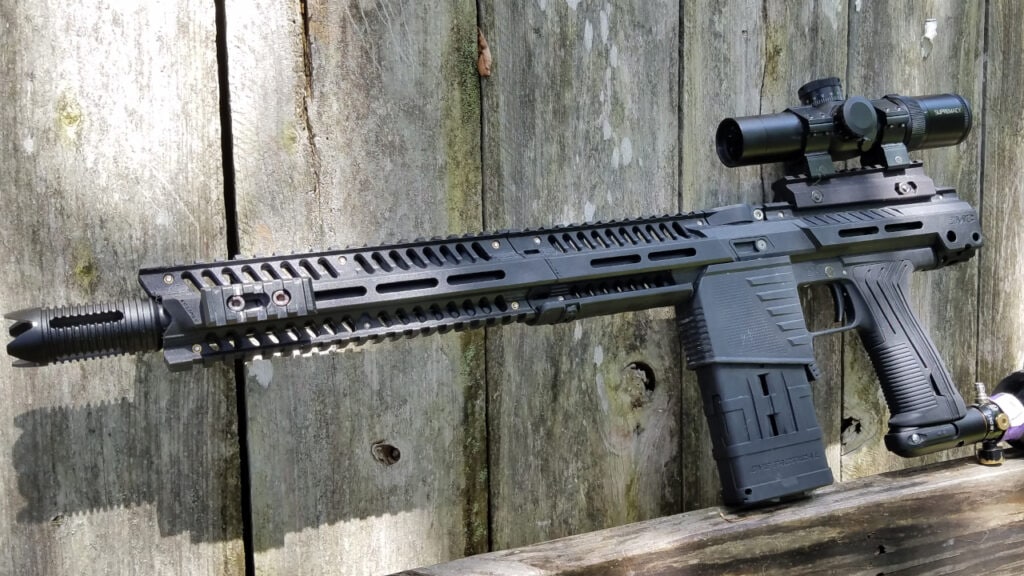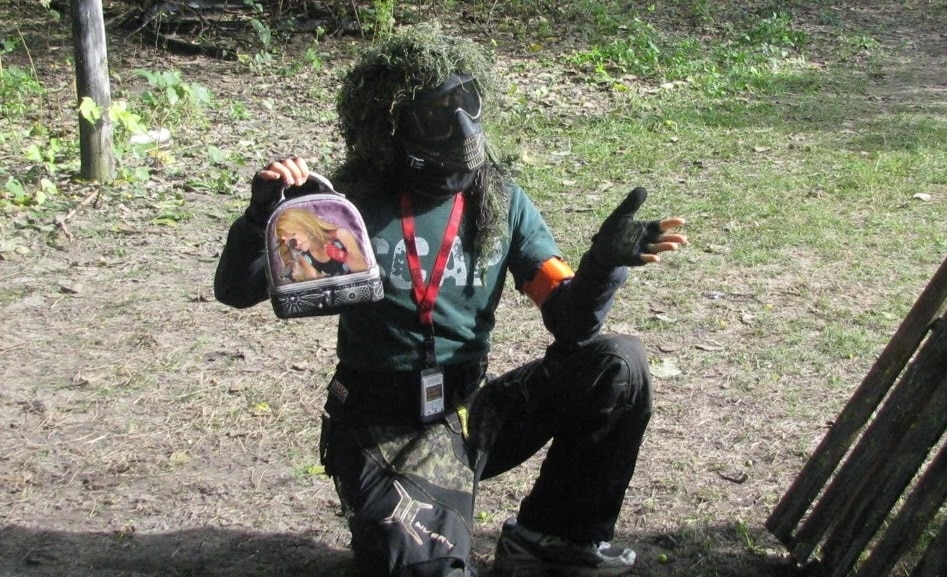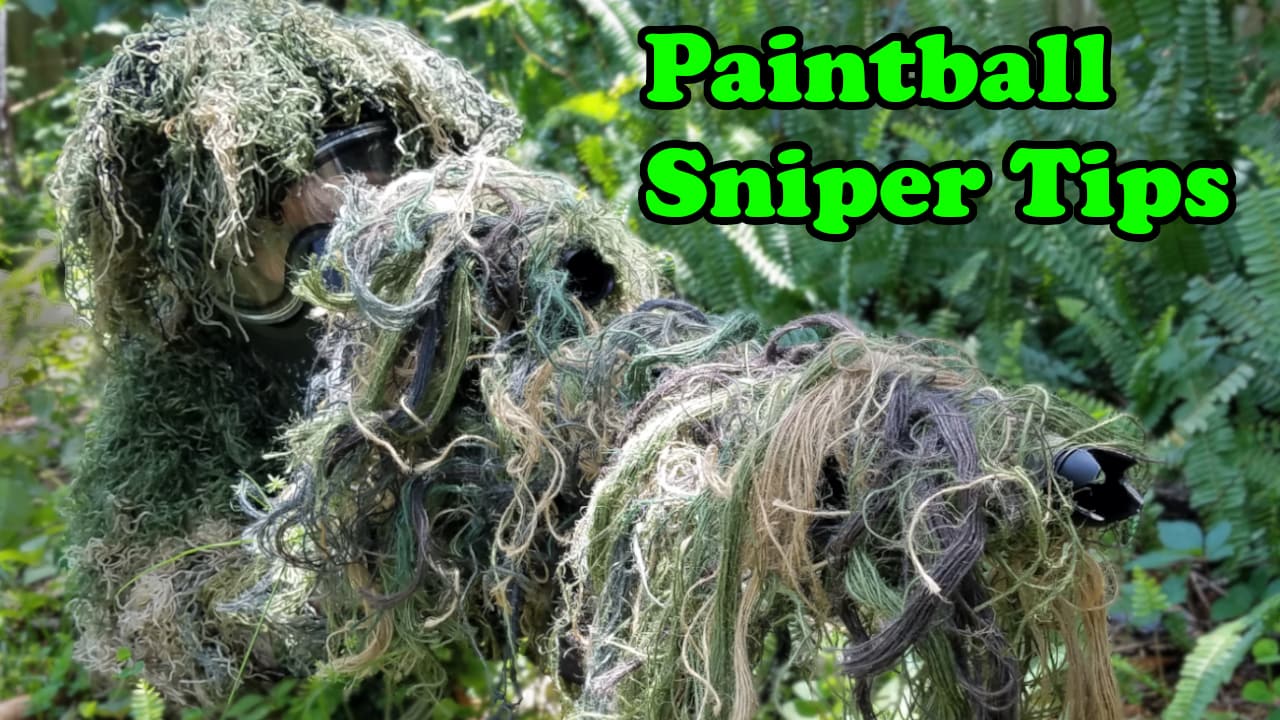After playing paintball for over 20 years, I have found that one my favorite rolls to play is a paintball sniper.
Playing as a modern day paintball sniper requires more than just the general stealth and sabotage skills required of years past. With the addition of First Strike Rounds (FSR) you have the ability to shoot well beyond the normal engagement distance of a regular paintball. This provides a real, and very useful, advantage over using regular paintballs.
Today’s sniper needs to be able to shoot accurately at long distances to support your team and be able to stealthily get behind enemy lines to cut off reinforcements. You may find yourself alone on the field and the only person available to successfully eliminate a mission squad or recover a prop.
Here are 26 of the most valuable tips and tricks I have learned on how to be a paintball sniper for both small games and large scale scenario events.
The first 4 tips may sound basic, but they are absolutely essential to get right from the beginning.
Table of Contents
Use High Quality Paintballs or First Strike Rounds

Common knowledge in paintball is that you have to use high quality paintballs to achieve maximum accuracy. As a sniper, you may only have the chance for one good shot, and by using high quality paint, or FSR, your chances to hit your target is drastically increased.
Ideally, you want to find paintballs with no dimples, is consistently round, not too brittle (especially if running magfed), and without moisture in the bag. This can be really hard to do sometimes and even FSR can have their problems. If you can inspect the bags before buying, do it. It will save you some headaches in the long run.
This tip goes beyond actually buying the best paint that money can buy, but buying the best paint you can buy that works with your paintball gun and weather. You have to make sure your paint will survive any humidity or spring-fed loading system without deformation.
If you are using a spring fed tube or magfed paintball gun, you may find that the humidity can impact how well your paintballs will perform. Paintballs are like sponges and can quickly absorb moisture in the air, causing them to become soft and deformed. If you are using a spring fed system, use a paintball with a harder shell for best results.
More than once, I have had to clear a jam caused by a soft paintball in the middle of a firefight, or clear a crushed FSR that was damaged and flipped in the chamber. Inspect your paint before use and make sure you know how the weather will affect it while on the feild.
Pick a Reliable Paintball Gun

Next to using quality paintballs, using a reliable and consistent paintball gun will allow you to keep shooting paint without any worries of jams or failures.
Every single event that I have gone to there has been quite a few people with gun failures of some kind. Some are because the paintball gun was old or very heavily used, but most have been from overly customized and magfed paintball guns. These people are usually back at camp doing repairs, at the customer service booths at events, or using borrowed gear just so they can hit the field.
I’m all for using gear that you like, but strongly advise players to use reliable gear that doesn’t jam or stop working when you need it. I have been in this position myself and have purged my entire fleet of paintball guns down to my most reliable and consistent platforms.
If you want to see my favorite paintball guns on the market, check out my recommended gear page by clicking the link below:
https://www.paintzapper.com/best-paintball-gear/
Use a Quality Barrel

In order to achieve maximum accuracy, you will need a quality paintball barrel to control the paintball while it is accelerating to velocity. If you are able to take care of the above two tips, this will squeeze out every last bit of accuracy out of the paintball or FSR.
Lots of mid range mid-range paintball guns come with a basic, overbored barrel that isn’t tuned for accuracy. Plus, if you are using FSR, they aren’t rifled and wont apply any rotational force to the round before it leaves the barrel. This can lead to some loss in accuracy and stability.
I personally like to bore match my regular paintballs to the barrel, where there is just enough room for the ball to easily blow out, but it doesn’t get stuck or just roll out. This is achieved by using barrel kits like the Freak Barrel and other similar barrel kits.
For FSR, I have found that the Hammerhead OneShot Barrel is the perfect balance in cost and accuracy for a rifled barrel. There are others on the market that cost more, but the gains in accuracy are minimal (if any).
For more information on how to increase your paintball guns accuracy, check out my link below:
https://www.paintzapper.com/make-your-paintball-gun-more-accurate
Use the Right Scope

One major mistake that many people make is using a scope with high magnification or a very short eye relief. These two problems just by themselves can make a scope unusable for paintball.
If you are using a scope with 3x or more magnification, you will have a harder time finding your target at standard ranges for paintballs or even FSR. Plus, they may be harder to focus on targets closer to you as their focal length is set to be much further away.
I like to use 1x to 2.5x magnification on my scopes and reflex sights as they allow me to have a wider field of vision and is easier to acquire my targets in a fast paced sport of paintball. Anything more than that just makes it harder to scan my surroundings and lock on to my target.
The focal length is the distance your eye needs to be from the rear scope lens to see the entire image provided by the scope. If it is too short of a distance, your mask will interfere with the scope and not allow you to achieve the full picture, or even scratch your lens.
My favorite scope for FSR is the Carmatech Supremacy scope as each tic is calibrated to the proper ranges and has a longer eye relief for easy use on the field. You can pick one up directly from Carmatech by clicking here.
Sight in Your Optics at Engagement Range
If you aren’t using one of the calibrated scopes from Carmatech, you will want to sight in your optics at your average engagement range. The only way you will know the right distance is by actually playing paintball or shooting a lot of paint at various targets at different ranges.
For paintballs, I sight my reflex sights and 1x scopes to a point just after the ball starts to arc down. This, for me, is my typical engagement distance and I can adjust my point of aim on the fly for varying distances by raising or lowering my sights point of aim.
For FSR, you will want to become very familiar with the range that you set your scope to on the field and on the practice range. You will have to determine the approximate range of your target and adjust the point of aim for the varying ranges.
In normal games, you should never have to adjust the zero on the field by adjusting the windage and elevation knobs on the scope. I find that once you have the scope sighted in properly, you can easily compensate for range or wind by using the tics on your scope.
Shoot Without Tilting Your Gun When Using a Scope
If you are using an optic to shoot long range, you want to make sure your paintball gun is not leaning to the side when using the scope to aim. You want to keep the scope windage as level as possible as if you start to lean the gun to one side, the paintball path and scope point of aim will no longer match, causing your shots to go wild.
You can raise the tip elevation as much as you need but never lean your gun to the side when shooting with an optic. I have seen people use this simple bubble level from Amazon that attaches to their picatinny rail that lets them know that their gun is perfectly positioned when shooting.
Practice Shooting At Different Ranges
The key to any good sniper is being able to make that key elimination with just one shot at any range. This is only done with lots of on field experience (and some luck). Without practice using the same platform over and over again, you will never be able to consistently take out a target with just one shot.
You can practice this skill off the field by stapling paper plates to wooden posts, boxes, or trees at various ranges and shooting at them from a variety of different positions. This will help you identify how much of an arc you will have to apply to the round, but will never fully replace on the field experience with moving players and overhead cover.
Know Your Maximum Effective Range
Simply knowing how far you can accurately shoot a paintball with it still breaking on target is the key to long distance shooting. There are a lot of factors besides that actual range of the target that can affect this distance, like paint quality and overhead cover.
You need to be able to understand how your paint will fly in the surrounding environment and know if other external factors, like humidity, will change the flight characteristics of your paint.
This will take time to learn with plenty of trial and error, but after a while you will know what shots will fly true or wont reach your target.
Wear the Right Clothes for Your Environment

If you are playing in a wooded environment and want to blend in, pick the right camouflage for your location. Camo will help you blend in to your environment a bit more by distorting your outline, but camo is not universal. Match the camo you will be wearing to what you anticipate hiding in.
You can also pick up various ghillie suits to help further break up your outline and help you blend into your environment. When wearing a ghillie suit, I like to roll on the ground really quick to pick up extra leaves and debris from my environment to further add to the illusion.
Study The Field Layout
An effective sniper knows where key landmarks are, what heavily used trails to keep an eye on, and prime shooting positions to take advantage of no matter where they are on the field.
Without this basic information, you will not be able to effectively control the field and disrupt the other team. As a sniper, your task is to equally provide crowd control and deception all while supplying intel back to your team on key movements and missions.
Stay Mobile and Aware
Most new players associate sniping with finding a spot to camp and wait for your targets to show up. This can’t be further from the truth, an effective paintball sniper needs to be mobile and out of sight.
If a sniper sits and only controls one spot, the other team will eventually learn their position and either send in a squad to flush them out or avoid the area all together. This will render the sniper completely useless and allow the other team to gain the upper hand.
Sometimes you will find a good spot to take out the other team with multiple eliminations, but if you keep rotating your position in a circular path around the target location you can stay hidden for longer while spreading out your area of control.
By staying agile, you do two things; keep the other team on their toes as they think a sniper is still in your previous location and possibly dedicate players to flush out a player that isn’t in the area.
Hide In the Bushes

There is more to the picture above, if you didn’t see me at first take another look!
Don’t be afraid to crawl under a bush or in a cluster of plants to help hide yourself from players walking past. Having a little overhead cover mixed with matching camo has allowed me to hide from large mission teams walking mere feet from my location.
These locations can be quite defensible if played correctly. By using the illusion of stealth, you can remain hidden while slowly reducing the other teams numbers. This is even more effective if you have a distraction elsewhere allowing you to pluck off the other team one by one without consequence.
Use Natural Blinds and Shoot Through The Holes
One of my favorite tactics is to stalk other players is using the environment to mask my advance. Then once I find a good position, I locate a hole in the bushes or structures that are probably 10 to 20 feet in front of me to eliminate my target.
You don’t have to be right up on your cover to place effective shots. Matter of fact, if you stay several feet back from the cover, it will help further protect you from incoming fire as the paint will loose lots of its momentum trying to get through the brush.
Pick the Right Targets

Sometimes you will have to prioritize high value or more aggressive targets before taking out the easy ones not pushing the line. These targets could range from Generals, LAW Players, Medics, or even a handful of players pushing the front line.
You will learn really quickly what eliminations will give your team points or help you secure an area. If you see players advancing on your team or special units, take them out first before they push your team back. Your team can suppress the non aggressive players for you but will need help to secure their location without any of your team getting eliminated.
Shoot No Faster Than 1 Shot Per Second
Unless you are in a direct firefight, try to shoot no faster than 1 shot per second. This will do several things; reduce the chance of the other team will pinpoint your position, conserve paint, and reduce the need to constantly reload.
Your primary goal as a sniper should be eliminating targets and disrupting the other team without being noticed. Let the pod carrying players do the heavy suppressive fire, you need to eliminate with precision or use the distraction to slip past their front lines and attack from the rear.
Identify Your Escape Routs
There will be a time when you may bite off more than you can chew (been there done that) and having an effective escape rout will allow you to quickly retreat and possibly set up an ambush for pursuing players.
All you need to do is know that you have a way out that is still possibly clear or has allies available to provide cover for a hot retreat. Even knowing where a good bush to hide in is better than nothing in a pinch.
Carry a Sidearm

If you are using a magfed setup or any other limited paint setup, pulling out a sidearm is faster to do than reloading and can be the difference between getting eliminated or winning the firefight.
They are also handy if you are shooting FSR and don’t want to engage players up close with the more expensive rounds. Some fields also request that you try not to shoot other players withing 40 feet with FSR as they have a bit more of a sting to them, so having a sidearm allows you to engage closer players without the guilt.
Practice Good Gear Management

A sniper needs to be quick on their feet and be able to quickly reload without any hesitation. The player may also have to crawl into tight places where you wont be able to grab your mags very easily.
Be mindful of how you will pull mags or paint from your pouches and where you will store the empties. I like to use simple mag pouches with a dump pouch on a belt system for high mobility, low weight and no funky chest rigs.
Customize Your Gear to Fit Your Needs
At the end of the day, it is your gear and you should set it up exactly to how you want it. Customizing your entire setup, from pack to gun, will require on the field troubleshooting to see what works and what is needed.
Keep in mind how much weight you will be adding to the entire system. If you play large scale scenario games, the extra weight will slow you down and fatigue you faster and cause you to be less effective on the field.
I personally aim to run with the bare minimum with little to no frills for best results. This has allowed me to continue causing chaos on the field for 2-3 hours at a time before needing a break.
Plan for Extended Field Time

There will be times where you get hungry or thirsty on the field but are loathe to give up your location. This is where some extra field prep comes into play.
One of my teammates will usually bring a small lunchbox on his persons containing small snacks and drinks for when he is on the field. Having small treats like granola bars and juice pouches can help you stay hydrated and fed while on the field without ever having to take off your mask.
Know How to Play Your Roll
When playing a large scale scenario event or themed game, make sure you understand the basic role of the sniper and what the event expects of you.
Sometimes an event will apply special rules to snipers where you can’t get within so many feet the other teams base, a minimum engagement distance for FSR, and even special rules to players wearing ghillie suits.
Plus, your teammates will have their own expectations of the sniper. They may expect you to scout ahead for them and relay information back to the team to help them advance safely.
Stay in Communication With Your Team
While scouting ahead, you will observe valuable information that your team will need to know. However, constantly running back to your front lines may lead you to miss something or get spotted by the other team.
A sniper is best suited to have a radio on hand to quickly relay information back to their main base or the front lines. This will help provide accurate intel and help move your team forward in the right direction.
You Can Be a Diversion

There may come a time where a high value player on your team needs to retreat or a diversion is needed to allow an entire team to move unnoticed. This is when you use the intimidation factor of your class to great effect.
A sniper can allow the other team to purposefully catch a glimpse of you while moving from location to location or have to deal with you head on by popping up out of the bushes and quickly eliminating a handful of their teammates. By doing this, you will catch the other team off guard and possibly pull all of their focus on the new and prominent threat.
Other players don’t want to have to deal with a sniper, especially if they are picking off their teammates one by one. More than once have I heard players say “don’t go there, there is a sniper in the woods” or yell out “there is a sniper to our right!” This shows that a good sniper is a threat, either seen or unseen and can effect how the other team reacts.
Leave a Backup Paintball Gun at Your Base
On several occasions, I found that we were pushed back to our base and the only real support that can be offered is some good ol f ashen firefights. Using FSR can get very expensive in these fast paced engagements and having a setup for regular paintballs at your base allows you to help apply some direct force quickly and efficiently.
Coordinate with Other Snipers
What is scarier than one sniper? Two snipers working together!
If you run across another sniper, you can work together by covering each others flanks as you advance. This will speed up how much ground is covered and keep each other protected.
Stalking other players in the woods is highly effective when done in coordinated pares. Some of my friends who have been on the receiving end of my wife and I stalking them have equated it to being followed by two stealthy raptors.
Cover Reflective Surfaces and Use Non-Reflective Lenses

The last thing you want when hiding in the bushes is for your scope or mask lens reflecting the light and giving away your position. I strongly advise against having any sort of mirrored lens if you want to be stealthy as it is usually the first thing that will catch another players eye.
Also, using a scope diffuser will help hide the reflection of the scope and keep you hidden while taking aim. There have been a handful of times where I was able to pinpoint a players location just because of a quick flash of their scope giving them away.
Use any advantage you can find take to hide yourself and keep on sniping.

